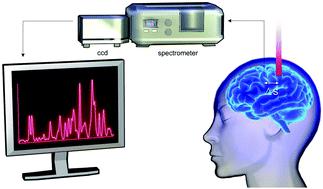当前位置:
X-MOL 学术
›
Chem. Soc. Rev.
›
论文详情
Our official English website, www.x-mol.net, welcomes your
feedback! (Note: you will need to create a separate account there.)
Spatially offset Raman spectroscopy for biomedical applications
Chemical Society Reviews ( IF 40.4 ) Pub Date : 2020-11-10 , DOI: 10.1039/d0cs00855a Fay Nicolson 1 , Moritz F Kircher , Nick Stone , Pavel Matousek
Chemical Society Reviews ( IF 40.4 ) Pub Date : 2020-11-10 , DOI: 10.1039/d0cs00855a Fay Nicolson 1 , Moritz F Kircher , Nick Stone , Pavel Matousek
Affiliation

|
In recent years, Raman spectroscopy has undergone major advancements in its ability to probe deeply through turbid media such as biological tissues. This progress has been facilitated by the advent of a range of specialist techniques based around spatially offset Raman spectroscopy (SORS) to enable non-invasive probing of living tissue through depths of up to 5 cm. This represents an improvement in depth penetration of up to two orders of magnitude compared to what can be achieved with conventional Raman methods. In combination with the inherently high molecular specificity of Raman spectroscopy, this has therefore opened up entirely new prospects for a range of new analytical applications across multiple fields including medical diagnosis and disease monitoring. This article discusses SORS and related variants of deep Raman spectroscopy such as transmission Raman spectroscopy (TRS), micro-SORS and surface enhanced spatially offset Raman spectroscopy (SESORS), and reviews the progress made in this field during the past 5 years including advances in non-invasive cancer diagnosis, monitoring of neurotransmitters, and assessment of bone disease.
中文翻译:

用于生物医学应用的空间偏移拉曼光谱
近年来,拉曼光谱在深入探测生物组织等浑浊介质的能力方面取得了重大进展。这一进展得益于一系列基于空间偏移拉曼光谱 (SORS) 的专业技术的出现,能够对活体组织进行高达 5 厘米深度的非侵入性探测。与传统拉曼方法相比,这意味着深度穿透能力提高了两个数量级。结合拉曼光谱固有的高分子特异性,这为医疗诊断和疾病监测等多个领域的一系列新分析应用开辟了全新的前景。本文讨论了 SORS 和深层拉曼光谱的相关变体,例如透射拉曼光谱 (TRS)、微 SORS 和表面增强空间偏移拉曼光谱 (SESORS),并回顾了过去 5 年在该领域取得的进展,包括非侵入性癌症诊断、神经递质监测和骨疾病评估。
更新日期:2020-12-09
中文翻译:

用于生物医学应用的空间偏移拉曼光谱
近年来,拉曼光谱在深入探测生物组织等浑浊介质的能力方面取得了重大进展。这一进展得益于一系列基于空间偏移拉曼光谱 (SORS) 的专业技术的出现,能够对活体组织进行高达 5 厘米深度的非侵入性探测。与传统拉曼方法相比,这意味着深度穿透能力提高了两个数量级。结合拉曼光谱固有的高分子特异性,这为医疗诊断和疾病监测等多个领域的一系列新分析应用开辟了全新的前景。本文讨论了 SORS 和深层拉曼光谱的相关变体,例如透射拉曼光谱 (TRS)、微 SORS 和表面增强空间偏移拉曼光谱 (SESORS),并回顾了过去 5 年在该领域取得的进展,包括非侵入性癌症诊断、神经递质监测和骨疾病评估。











































 京公网安备 11010802027423号
京公网安备 11010802027423号